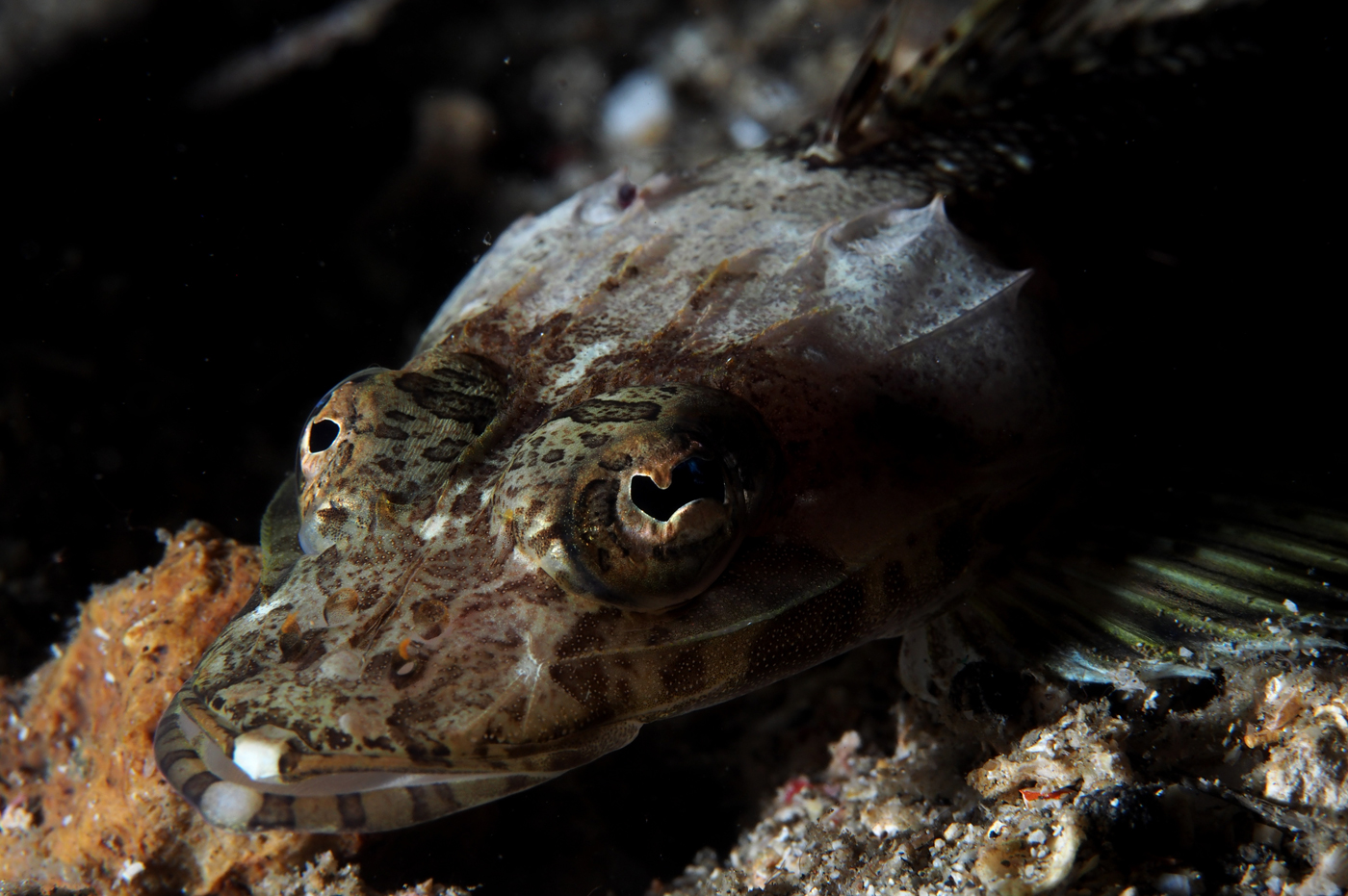Serrate Flathead, Rogadius serratus (Cuvier 1829)

A Serrate Flathead, Rogadius serratus, at Anilao, Philippines. Source: Rickard Zerpe / Flickr. License: CC BY Attribution-ShareAlike
Serrate Flathead, Rogadius serratus (Cuvier 1829)
More Info
|
Distribution |
In Australia known only from the Capricorn Bunker group, Great Barrier Reef, Queensland. Recorded internationally from Mauritius, Seychelles, Somalia, Pakistan, Sri Lanka, Maldives, Chagos Archipelago, Indonesia, Philippines, Port Moresby, and New Caledonia. Inhabits silty snad and rubble areas near reef in depths of 5-45 m. |
|
Features |
Dorsal fin IX or I,VIII, 11 (rarely 12); Anal fin 11; Pectoral fin 20-23; Pelvic fin I, 5; Lateral line scales (pored) 51-54 (rarely 50). Body elongate, depressed. Head moderately depressed, lower side of head unicarinate; supraorbital and suborbital ridges bearing many fine serrations; preorbital spine absent, several small serrations present; a single preocular spine with an accessory spine on anterior base; ocular flap absent; teeth on vomer in two separate patches. Preopercular spines 4 or 5 (usually 5); uppermost longest, with an accessory spine on base, weak antrorse spine present, tip of antrorse spine sometimes difficult to see. Gill rakers 6-8 (usually 7). Interopercular flap absent. Oblique scale rows slanting backward above lateral line about equal to number of lateral-line scales. Lateral-line scales usually 51-54 (rarely 50), anterior 1-9 scales bearing a small spine. scale pores of lateral line with 2 openings to the outside. First dorsal fin spinous, base almost as long as base of second dorsal fin, first spine very short, attached to second spine by a low membrane, following spines much longer. Second dorsal fin with moderately long base, anterior rays longest, nearly as long as longest first dorsal spines. Anal fin similar in shape, opposite and slightly longer-based than second dorsal fin. Caudal fin truncate to slightly rounded. Pectoral fins moderately long. Pelvic fins long, reaching to about anal fin origin. |
|
Size |
Maximum total length about 24 cm, commonly to 15 cm. |
|
Colour |
Body and head light tan dorsally, head with a broad suborbital dark bar, head and body paler below, back crossed by about 7 or 8 dark bands, sides with a series of dark blotches. Spinous dorsal fin dusky. Second dorsal fin with dark brown spots along rays. Caudal fin with a dark band basally; whitish central band; blackish submarginal band becoming paler above; upper area usually with a few distinct dark spots; pectoral fins dark below with whitish edge, pale above with dark spots. |
|
Fisheries |
May be taken as bycatch in commercial trawls. |
|
Conservation |
|
|
Species Citation |
Platycephalus serratus Cuvier, in Cuvier & Valenciennes,1829, Hist. Nat. Poiss., 4: Sri Lanka. |
|
Author |
Australian National Fish Collection, CSIRO & Bray, D.J. 2017 |
|
Resources |
Serrate Flathead, Rogadius serratus (Cuvier 1829)
References
Cuvier, G.L. in Cuvier, G.L. & Valenciennes, A. 1829. Histoire Naturelle des Poissons. Paris : Levrault Vol. 4 518 pp. pls 72-99.
Imamura, H. 1996. Phylogeny of the family Platycephalidae and related taxa (Pisces: Scorpaeniformes). Species Diversity 1(2): 123-233
Imamura, H. & Amaoka, K. 1996. Rogadius serratus (Cuvier, 1829), a senior synonym of R. polijodon (Bleeker, 1853) (Scorpaeniformes: Platycephalidae). Ichthyological Research 43(1): 97-100
Knapp, L.W. 1999. Family Platycepalidae. pp. 2385-2421 in Carpenter, K.E. & Niem, T.H. (eds). The Living Marine Resources of the Western Central Pacific. FAO Species Identification Guide for Fisheries Purposes. Rome : FAO Vol. 4 pp. 2069-2790.
Russell, B.C. 1983. Annotated checklist of the coral reef fishes in the Capricorn-Bunker group, Great Barrier Reef, Australia. Great Barrier Reef Marine Park Authority. Special Publication Series 1: 1-184 figs 1-2





